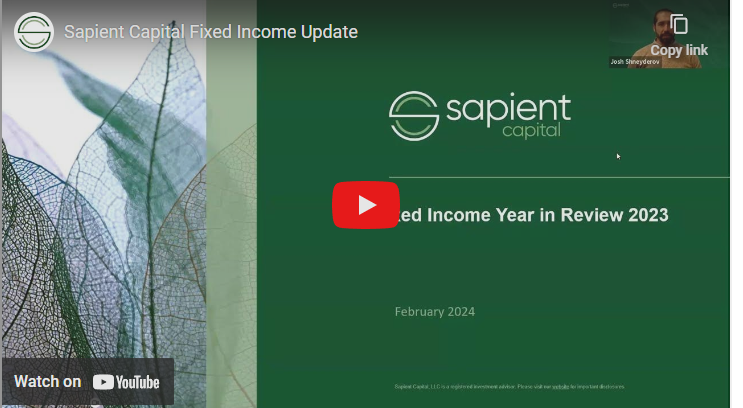Where we stand, and where we think we’re headed.
[6 minute read]
Tom Pence is a Founding Partner at Sapient Capital, where he oversees the active equity portfolios of the firm.

Macro Observations:
The story of 2023 so far has been better than expected U.S. economic data and a remarkable explosion of interest in Artificial Intelligence. [We recently hosted an Introduction to A.I. Expert Call with Rohit Krishnan, available here].
Up until May, essentially the entirety of the market’s return was down to 7 megacap technology stocks. With the rally broadening out somewhat since, we felt it would be a good time to examine where we are, and where we think we’re headed.
Here’s where I believe we stand now:
In short: There’s a strange combination of factors unfolding here where consumer spending seems to be ebbing or peaking, consumer products and services are increasingly unable to push price, earnings could be impacted negatively, but workers are more likely to hold onto their jobs.
- Demand is decelerating: Demand for units at most consumer companies has been decelerating all year. In 2022 and early 2023, weak unit demand was offset by elevated pricing power. But there is evidence that this too is now decelerating as consumer demand begins to wane based on affordability (cars, airfares, hotels) or from satiated demand (consumers have enough stuff).1
- But wages are strong. Despite y/y disinflationary forces unfolding, wage growth has remained strong at 4.5%. This combined with underemployment could be reflecting the unwillingness of companies to let go of workers. U.S. demographics also support a case for wage growth to remain at a healthy mid-single-digits level longer term vs the low-single-digits levels that existed for the decade before the pandemic.2
- And consumers are still healthy. The consumer interest burden relative to income is at cycle low levels, which is not indicative of a recession and suggests consumers are not overly indebted, nor particularly sensitive to higher interest rates. Excess consumer savings from the pandemic remain elevated, but much lower than the beginning of the year. Plus, credit card balances are beginning to rise.3
Looking into the back half of the year, could an earnings recession unfold in Q4 that causes the Fed to begin cutting rates? If so, we believe this could cause markets to rally after a brief hiatus in the fall as the market looks to an earnings recovery and the prospect of a positively sloped yield curve in 2H 2024.
Despite a broad disinflationary trend as pandemic excesses are fully unwound into 2024, raw materials inflation (mostly metals and rare earths) could remain elevated longer term. This would result from the combined forces of normal cyclicality, deglobalization/strategic hoarding of resources and from increasing demand from green energy capex and subsidies. Along with wage pressure from demographics, this could result in longer term inflation trending around 3-4% and 10-year T Bond yields normalizing around 4.5-5%.
What are the investment Implications?
We expect a moderate earnings and profit down-cycle to unfold this fall and put pressure on P/E multiples. Some employment slack will inevitably follow, but should be muted by the effect of the consumer remaining strong, continued housing market strength and the prospect of the fed moving towards an easing cycle.
What we like:
- High Free Cash Flow & Stable Revenue Growth: In the midst of a dubious economic outlook and earnings trend, we would expect companies generating high free cash flow and stable revenue growth to outperform.
- This includes many of the top tech and consumer names who are in the midst of harnessing Artificial Intelligence to improve their product and service offerings such as MSFT, AAPL, META, GOOGL, ORCL, NVDA, AMZN, MA, V, BKNG, WDAY and INTU.
- It also includes companies not as directly benefiting from A.I. initiatives but with equally strong free cash flow margins such as UNP, PANW and MELI, PXD and EOG.
- Energy stocks. Despite a global commitment to an energy transition away from carbon-based fuels, the transition should take longer than most anticipate. It may also require spending on cleaner carbon fuels such as natural gas to bridge the gap. Although many of these stocks will be volatile in the face of a global slowdown, valuations of companies such as Chevron, BP, XOM, Pioneer and EOG offer compelling value and growth prospects.
- Commodities & Raw Materials. We have written previously about the investment paradox of the decade “the capex needs of a multipolar, environmentally conscious, world are enormous. But, nobody wants to invest in capex for commodities”. With the increasing awareness of the importance of securing capacity within strategically important industries and raw materials, we anticipate a tightening of capacity. Increasing demand from energy transition spending should result in a strong bid for raw materials such as Natural Gas, Copper, Aluminum, Nickel, Lithium, Cobalt, Silver and Uranium. This could have positive implications for companies such as Freeport McMoRan, Albermarle, Teck and Anglo American.
- [Friend of the firm Marko Papic at Clocktower recently gave a superb interview on the investment paradox of the decade which expands on this theme in detail].
What we don’t like:
We will continue to de-emphasize the following into 2024:
- Emerging growth companies with unreasonable valuations, which are still susceptible to multiple pressure.
- Staples sector stocks that offer safety and remain overvalued relative to the expected shallow depth of the unfolding recession.
- Banks which continue to face competition for loan growth, higher funding costs and higher regulatory scrutiny that will pressure their ROAs.
- Chinese stocks which have become more aligned with government-mandated initiatives and less focused on shareholder value creation.
Please let us know what’s on your mind, and any questions and comments you have.
Tom Pence and the team at Sapient Capital
[Sign up for future updates below]
The information provided is for educational and informational purposes only and does not constitute investment advice and it should not be relied on as such. It should not be considered a solicitation to buy or an offer to sell a security. It does not take into account any investor’s particular investment objectives, strategies, tax status or investment horizon. You should consult your advisor.
The views expressed in this commentary are subject to change based on market and other conditions. These documents may contain certain statements that may be deemed forward looking statements. Please note that any such statements are not guarantees of any future performance and actual results or developments may differ materially from those projected. Any projections, market outlooks, or estimates are based upon certain assumptions and should not be construed as indicative of actual events that will occur.
The following piece contains information regarding securities that our advisors find favorable. However, this list is not an exhaustive representation of all the securities that our firm may endorse or currently hold in our portfolios. Furthermore, it is important to note that some of the securities mentioned herein may be part of our portfolios, while others are not.
All information has been obtained from sources believed to be reliable, but its accuracy is not guaranteed. There is no representation or warranty as to the current accuracy, reliability, or completeness of, nor liability for, decisions based on such information and it should not be relied on as such.
Sapient Capital LLC is a registered investment advisor. Advisory services are only offered to clients or prospective clients where Sapient Capital and its representatives are properly licensed or exempt from licensure.
1 Source: https://www.census.gov/retail/sales.html
2 Source: https://www.bls.gov/eci/home.htm
3 Source: https://www.federalreserve.gov/releases/g19/current/


